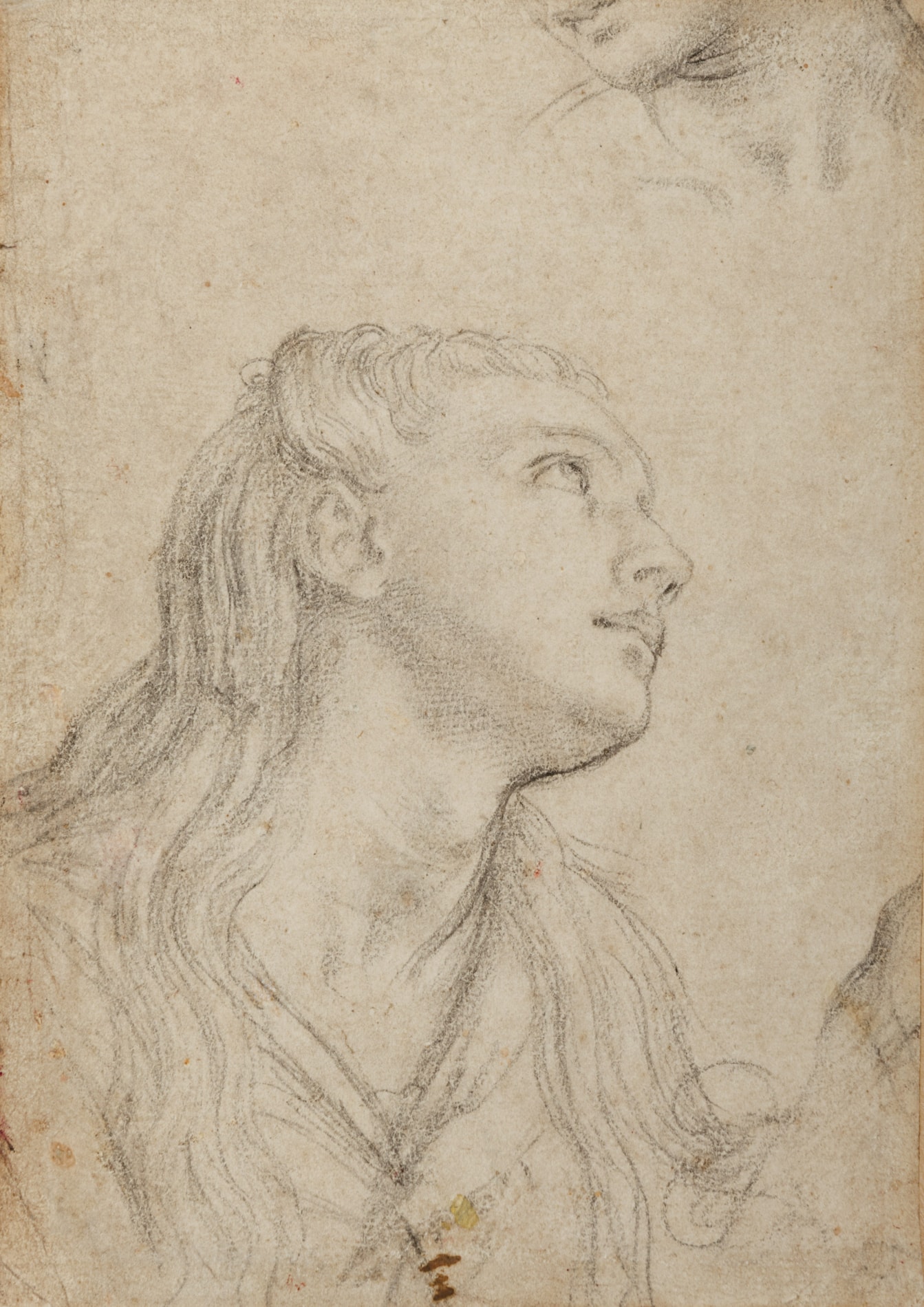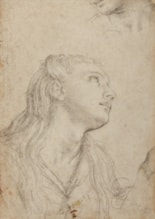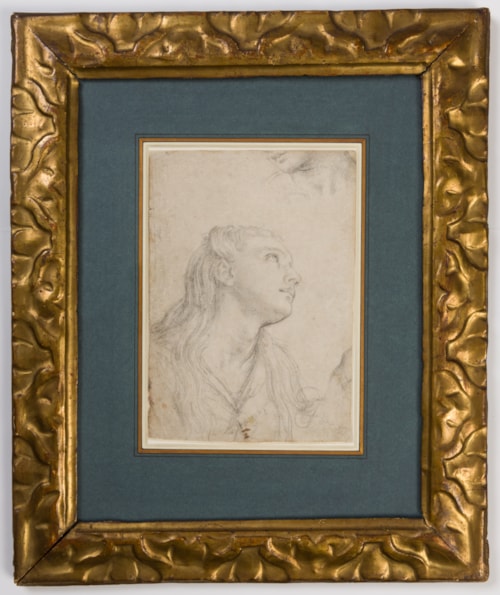Alessandro ALLORI
(Florence 1535 - Florence 1607)
The Head of a Young Woman Looking Upwards, with a Partial Study of a Head Above
Black chalk.
217 x 155 mm. (8 1/2 x 6 1/8 in.)
217 x 155 mm. (8 1/2 x 6 1/8 in.)
Alessandro Allori was a gifted draughtsman, and his oeuvre displays a reverence for the 16th century Florentine tradition of disegno established by such earlier artists as Michelangelo, Andrea del Sarto and Pontormo, as well as his adoptive father Bronzino, whose influence is evident throughout his career. Around three hundred drawings by the artist are known, the vast majority of which, amounting to some 270 sheets or around 90% of the total, are in the collection of the Uffizi in Florence. As such, his drawings appear only rarely on the art market.
This drawing is a study for the head of the Magdalene in Allori’s altarpiece of The Resurrected Christ Appearing to Mary Magdalene (Noli me tangere), apparently dated 1584, in the Confraternita della Misericordia church of the Santissima Trinità in Arezzo in Tuscany. (The painting is recorded as being signed and dated 1584, although its location high up on the wall of the church makes the inscription almost impossible to see today.) An identical head is also found in a later easel painting of the same composition, dated 1599, which was formerly in the Borghese collection in Rome and is today in a private collection. Likewise related is a compositional drawing of this subject, in the Yale University Art Gallery in New Haven, which seems to have been used as a preparatory study for a Noli me tangere tapestry woven between 1588 and 1598 for the Palazzo Vecchio in Florence.
An almost identical upturned head of the Magdalene is found in a black chalk drawing by Allori in the British Museum, in which the figure is shown full length and holding an open book. The British Museum drawing is in turn a study for a panel painting of Christ in the House of Martha and Mary, painted in 1578 for the chapel of the Palazzo Portinari-Salviati in Florence, and was also reused for an altarpiece of The Raising of Lazarus, dated 1593, in the church of Sant’Agostino in Montepulciano. A second version of Christ in the House of Martha and Mary, painted in 1605 and in which Mary is shown in reverse, is in the Kunsthistorisches Museum in Vienna. The same model seen in this drawing is also found, with minor variations, in other paintings by Allori, such as a Christ in Limbo painted in 1589 for the Cappella Salviati in the Florentine church of San Marco and a Penitent Saint Mary Magdalene of 1602 in the Museo Stibbert in Florence.
As one scholar has noted of a stylistically similar late drawing of a female saint by Allori, likewise drawn from a live model, ‘the complexion and profile of the face [do not] show any of the stiff, formal abstraction typical of Bronzino, which one finds in so many drawings from Allori’s youth; rather, they bear witness to a poetic attentiveness on the artist’s part to the more internalized aspects of reality and of the model drawn from life. This indeed was the most novel and personal aspect attained by Allori in his mature work.’ Among comparable drawings by Allori is a recently identified study of the head of the Virgin in the Museo Nazionale di Capodimonte in Naples, while similar female heads also appear in a number ofseveral drawings by the artist in the Uffizi, including a sheet of studies of heads, arms and hands and a study of the head of a woman, both drawn in black chalk.
Both the present sheet and the related 1599 easel painting of The Resurrected Christ Appearing to Mary Magdalene formerly belonged to the Chilean-born economist Alvaro Saieh (b.1949) and his wife, the architect Ana Guzmán, who established the private Alana Collection in the late 1990s. The Alana Collection was concentrated initially on Italian art of the Gothic and Renaissance periods but later expanded to include Baroque painting of the 16th and 17th centuries.
This drawing is a study for the head of the Magdalene in Allori’s altarpiece of The Resurrected Christ Appearing to Mary Magdalene (Noli me tangere), apparently dated 1584, in the Confraternita della Misericordia church of the Santissima Trinità in Arezzo in Tuscany. (The painting is recorded as being signed and dated 1584, although its location high up on the wall of the church makes the inscription almost impossible to see today.) An identical head is also found in a later easel painting of the same composition, dated 1599, which was formerly in the Borghese collection in Rome and is today in a private collection. Likewise related is a compositional drawing of this subject, in the Yale University Art Gallery in New Haven, which seems to have been used as a preparatory study for a Noli me tangere tapestry woven between 1588 and 1598 for the Palazzo Vecchio in Florence.
An almost identical upturned head of the Magdalene is found in a black chalk drawing by Allori in the British Museum, in which the figure is shown full length and holding an open book. The British Museum drawing is in turn a study for a panel painting of Christ in the House of Martha and Mary, painted in 1578 for the chapel of the Palazzo Portinari-Salviati in Florence, and was also reused for an altarpiece of The Raising of Lazarus, dated 1593, in the church of Sant’Agostino in Montepulciano. A second version of Christ in the House of Martha and Mary, painted in 1605 and in which Mary is shown in reverse, is in the Kunsthistorisches Museum in Vienna. The same model seen in this drawing is also found, with minor variations, in other paintings by Allori, such as a Christ in Limbo painted in 1589 for the Cappella Salviati in the Florentine church of San Marco and a Penitent Saint Mary Magdalene of 1602 in the Museo Stibbert in Florence.
As one scholar has noted of a stylistically similar late drawing of a female saint by Allori, likewise drawn from a live model, ‘the complexion and profile of the face [do not] show any of the stiff, formal abstraction typical of Bronzino, which one finds in so many drawings from Allori’s youth; rather, they bear witness to a poetic attentiveness on the artist’s part to the more internalized aspects of reality and of the model drawn from life. This indeed was the most novel and personal aspect attained by Allori in his mature work.’ Among comparable drawings by Allori is a recently identified study of the head of the Virgin in the Museo Nazionale di Capodimonte in Naples, while similar female heads also appear in a number ofseveral drawings by the artist in the Uffizi, including a sheet of studies of heads, arms and hands and a study of the head of a woman, both drawn in black chalk.
Both the present sheet and the related 1599 easel painting of The Resurrected Christ Appearing to Mary Magdalene formerly belonged to the Chilean-born economist Alvaro Saieh (b.1949) and his wife, the architect Ana Guzmán, who established the private Alana Collection in the late 1990s. The Alana Collection was concentrated initially on Italian art of the Gothic and Renaissance periods but later expanded to include Baroque painting of the 16th and 17th centuries.
The Florentine painter Alessandro Allori was adopted by the Medici court artist Agnolo Bronzino at the age of around five, after the death of his father. He received his artistic training in Florence, and assisted Bronzino on cartoons for the borders of tapestries for the Palazzo Vecchio before completing his education in Rome between 1554 and 1560, when he studied the works of antiquity and Michelangelo. On his return to Florence Allori was employed on the decoration of the Montauto chapel in the church of Santissima Annunziata and also painted a work for Santa Croce, while in 1565 he contributed to the decoration of an ephemeral triumphal arch erected for the entry into the city of Joanna of Austria, the bride of Francesco I de’Medici. Allori soon gained a number of significant commissions from two of the most prominent Florentine families, the Salviati and Medici. For the former he decorated the Palazzo Salviati in Florence and the family chapel in the church of San Marco, as well as the Salviati villa at Ponte alla Badia.
Allori’s Medici commissions included two paintings for the Studiolo of Francesco I de’Medici in the Palazzo Vecchio, a Banquet of Anthony and Cleopatra and a Pearl Fishers completed between 1570 and 1571. (The Pearl Fishers was painted on slate, and Allori also appears to have been one of the first artists to paint on lapis lazuli.) As court painter to the Medici Allori worked at their villa at Poggio a Caiano, where he completed a cycle of frescoes for the salone grande that had been begun by Jacopo da Pontormo, Francesco Franciabigio and Andrea del Sarto some fifty years earlier. The head of one of the most productive and busy workshops in Florence, Allori produced numerous paintings and altarpieces for churches in Florence and elsewhere in Tuscany. After around 1580 he began to move away from the cold and somewhat polished style of Bronzino in favour of a more refined, poetic and spiritual manner, best seen in his late religious pictures. He was active as a portrait painter and tapestry designer, serving as the director of the Arrazeria Medicea, the granducal tapestry works. Allori’s career marks the culmination of a long and prominent succession of Florentine painters that dominated art in Tuscany for over a century, beginning with Andrea del Sarto and passing through his pupil Jacopo Pontormo to that artist’s own apprentice Bronzino, who was in turn Allori’s master. Allori’s son Cristofano became a leading member of the succeeding generation of Florentine painters of the early Baroque period.
Allori’s Medici commissions included two paintings for the Studiolo of Francesco I de’Medici in the Palazzo Vecchio, a Banquet of Anthony and Cleopatra and a Pearl Fishers completed between 1570 and 1571. (The Pearl Fishers was painted on slate, and Allori also appears to have been one of the first artists to paint on lapis lazuli.) As court painter to the Medici Allori worked at their villa at Poggio a Caiano, where he completed a cycle of frescoes for the salone grande that had been begun by Jacopo da Pontormo, Francesco Franciabigio and Andrea del Sarto some fifty years earlier. The head of one of the most productive and busy workshops in Florence, Allori produced numerous paintings and altarpieces for churches in Florence and elsewhere in Tuscany. After around 1580 he began to move away from the cold and somewhat polished style of Bronzino in favour of a more refined, poetic and spiritual manner, best seen in his late religious pictures. He was active as a portrait painter and tapestry designer, serving as the director of the Arrazeria Medicea, the granducal tapestry works. Allori’s career marks the culmination of a long and prominent succession of Florentine painters that dominated art in Tuscany for over a century, beginning with Andrea del Sarto and passing through his pupil Jacopo Pontormo to that artist’s own apprentice Bronzino, who was in turn Allori’s master. Allori’s son Cristofano became a leading member of the succeeding generation of Florentine painters of the early Baroque period.
Provenance
Anonymous sale, Florence, Pandolfini Casa d’Aste, 22 May 2013, lot 99
Jean-Luc Baroni Ltd., London, in 2014
Acquired from them by the Alana Collection), Newark, Delaware.
Jean-Luc Baroni Ltd., London, in 2014
Acquired from them by the Alana Collection), Newark, Delaware.
Literature
London, Jean-Luc Baroni Ltd., Paintings, Drawings, Sculptures, 2014, pp.106-107, no.32.






